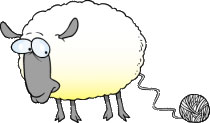5 perc Angol online magazin 2006. március 1. Szia! Ahogy azt tegnap megígértem, ma megismerjük Dolly, az els? klónozott eml?s állat történetét. Jó tanulást! Üdv,Nóri www.5percangol.hu CLONINGandTHE HISTORY OF DOLLY Dolly (5 July 1996 – 14 February 2003), an ewe, was the first mammal to have been successfully cloned from an adult cell.
 |
| |
| 5 perc Angol online magazin |
|
2006. március 1. |
|
|
Szia!
Ahogy azt tegnap megígértem, ma megismerjük Dolly, az els? klónozott eml?s állat történetét.
Jó tanulást!
Üdv,
Nóri
|
|
 |
CLONING
and
THE HISTORY OF DOLLY
|
Dolly (5 July 1996 – 14 February 2003), an ewe, was the first mammal to have been successfully cloned from an adult cell. She was cloned at the Roslin Institute in Scotland and lived there until her death when she was 6. Her birth was announced on 22 February 1997.
The sheep was originally code-named "6LL3". The name "Dolly" came from a suggestion by the stockmen who helped with her birth, in honour of Dolly Parton, because it was a mammary cell that was cloned. The technique that was made famous by her birth is somatic cell nuclear transfer, in which a cell is placed in a de-nucleated ovum, the two cells fuse and then develop into an embryo. When Dolly was cloned in 1996 from a cell taken from a six-year-old ewe, she became the centre of much controversy that still exists today.
On 9 April 2003 her stuffed remains were placed at Edinburgh’s Royal Museum, part of the National Museums of Scotland.
Creating Dolly
Dolly was created by a research team lead by Ian Wilmut at the Roslin Institute in Scotland. The goal of the research was the reliable reproduction of animals genetically modified to produce therapeutic proteins in their milk. Wilmut’s team had already created two sheep clones from embryonic cells grown in culture called Megan and Morag; the work was published in Nature in 1996. Dolly was a Finn Dorset lamb, created from fully differentiated adult mammary cells using a technique called somatic cell nuclear transfer; her creation was described in a Nature publication in 1997. Dolly was the first mammalian clone produced from an adult cell.
GLOSSARY FOR THIS UNIT
|
cell
controversy
differentiated
ewe
fuse
genetically modified
goal
in honour of …
mammal
mammary
nuclear
ovum
protein
reliable
reproduction
research team
somatic
stockman
stuffed remains
suggestion
therapeutic
to announce
to develop
to exist
transfer
|
sejt
ellentmondás
elkülönített
juh
egybeolvadás
genetikailag módosított
cél
… emlékére
eml?s
eml?-
mag-
pete
fehérje
megbízható
reprodukció
kutatócsoport
testi, fizikai
állattenyészt?
kitömött maradványai
javaslat
gyógyászati
bejelenteni valamit
kifejleszteni/fejleszteni valamit
létezni
átültetés
|
Forrás:
http://en.wikipedia.org/wiki/Dolly_the_sheep
http://news.bbc.co.uk/cbbcnews/hi/sci_tech/newsid_2764000/2764771.stm
|
|
A JÁTÉK FOLYTATÓDIK! AJÁNLJ, TOVÁBBÍTS, NYERJ!
Van egy remek ajánlatunk: ismertesd meg barátaiddal is az 5 perc Angol online magazint, s nyerhetsz! Küldd tovább 5 ismer?södnek az 5 perc Angol hírlevelet, a listára tedd fel az 5percangol@5percangol.hu címet is!
A hírlevelet továbbküld?k között értékes ajándékokat sorsolunk ki: három nyertesünk Szalai Nóri "5 perc Angol nyelvtan: Igeid?k" cím? könyvét kapja.
|
|




